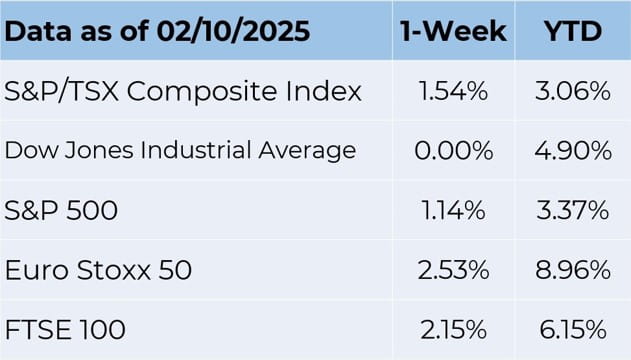Weekly Market Commentary February 24 2025
Canadian Economy on Edge
The Canadian economy would be on the brink of a protracted trade war with the U.S. That’s the sentiment echoed by the Bank of Canada governing council, following a recent policy meeting. While the central bank has cut interest rates six times, to three per cent, there are growing concerns that the economy could shrink significantly, should Donald Trump come through with the proposed 25 per cent tariffs on Canadian imports.
"It was clear that a protracted trade conflict would lead to a decline in economic activity," the minutes said. "Governing Council members also noted that the adverse impact on the level of GDP would be permanent, and the growth of GDP would be reduced until the Canadian economy adjusts to the tariffs."
While Canada has insisted it would retaliate should the U.S. impose tariffs, there are growing concerns that the country would pay a big price. That’s because Canada sends almost 75 per cent of its goods and services exports to its neighbour down south. According to anecdotal evidence, some Canadian companies are already considering moving to the United States, and a tariff war might encourage capital flight and reduce Canadian competitiveness.
Similarly, Canadian investors are trying to profit from a weaker Canadian dollar and anticipated volatility. Most are seeking protection in gold and shares of companies producing goods like uranium with few alternatives. Due to safe-haven demand that helped push the price of gold to a record high, the materials sector of the Toronto market is up almost 15 per cent this year. Despite the tariff threats, stocks related to metals and significant gains for technology shares have helped keep the TSX within striking distance of the record high it set in January.
As part of a comprehensive strategy to counter U.S. tariff threats, Canadian Conservative Leader Pierre Poilievre has promised to construct an east-west economy powered by gas and oil pipelines. The opposition leader is making a concerted effort to convince Canadians that he is the most qualified individual to guide the nation through an impending tariff war with its biggest trading partner.
In addition to reviving the natural resources industry to strengthen the nation's economy against threats from its southern neighbour, he pledged to retaliate forcefully against any taxes imposed by U.S. President Donald Trump.
On the other hand, Liberal leadership candidate Mark Carney claims that a federal government under his leadership would balance its operating spending over the next three years while running a deficit to invest and grow Canada's economy.
Carney, a former governor of the Bank of Canada, cited U.S. President Donald Trump's continuous threat of imposing broad tariffs on Canadian goods to support his proposed deficit. At a time when we must unquestionably develop as a nation, the goal is to invest in Canada's economy.
Meanwhile, the Canadian main stock index is struggling to bounce back after dropping 200 points last week, weighed by losses in the energy and basic materials segment. The country’s stock market has been on edge in recent weeks, amid growing concerns about U.S. President Trump's tariffs threat. The Toronto Stock Exchange has remained range-bound in the 25,400 area, awaiting key economic data that should paint a clear economic outlook.
While Canadian stocks have been choppy amid concerns around trade and inflation, the major averages are not far off their all-time highs. Investors are increasingly scanning for a catalyst for the next leg higher.
The Markets
Why are stock markets wary of tariffs?
In two of the last three weeks, tariff announcements led to late week stock market sell-offs. Stocks quickly recovered lost value, but uncertainty about the administration’s trade policy and the potential impact of that policy on U.S. companies remained. That’s likely to be the case until it becomes clear whether the Trump administration sees tariffs as a negotiating tactic or a means to cover the cost of extending 2017 tax cuts.
If tariffs are a negotiating tactic and unlikely to be implemented, the effect on the U.S. economy, businesses, and stocks may be less significant than if tariffs are put in place. The Tax Foundation evaluated the administration’s proposal for a universal baseline tariff and reported, “the 10 per cent tariff would generate $2 trillion of increased revenue, while the 20 per cent tariff would generate $3.3 trillion over a decade.”
While increased tax revenue is alluring, the catch is that tariffs are taxes added to the prices of materials and goods purchased by American businesses. Often, the cost is passed on to consumers, reported Anshu Siripurapu and Noah Berman of the Council on Foreign Relations (CFR). As a result, the trillions of dollars that could be generated would come from American pockets. According to CFR estimates:
“A 25 per cent tariff on Canada and Mexico will raise production costs for U.S. automakers, adding up to $3,000 to the price of some of the roughly sixteen million cars sold in the United States each year. Grocery costs could rise, too, as Mexico is the United States’ biggest source of fresh produce, supplying more than 60 per cent of U.S. vegetable imports and nearly half of all fruit and nut imports.”
Higher prices may reduce demand for goods and services, slowing sales and reducing companies’ profits (and earnings). If earnings growth slows, publicly traded companies’ stock prices could be affected. David Kostin, chief U.S. equity strategist at Goldman Sachs Research reported, “...every five-percentage-point increase in the U.S. tariff rate is estimated to reduce [Standard & Poor’s 500 Index] earnings per share by roughly 1-2 [per cent].” Goldman’s estimates suggest the 10 per cent tariff placed on China in early February could raise the effective U.S. tariff rate by about 4.7 percentage points.
In addition, businesses may be vulnerable to retaliatory tariffs imposed by other nations. For example, “American farmers and ranchers incurred the most widespread damage from this retaliation following the 2018 tariffs. The damage was so great that the [first] Trump administration authorized $61 billion in emergency relief payments to cushion farmers and ranchers from the blow…an amount roughly equivalent to all of the tariff revenue collected from U.S. businesses,” reported Adam S. Hersh and Josh Bivens of The Economic Policy Institute.
Investors appeared to shrug off concerns about tariffs and trade wars last week. Denitsa Tsekova of Bloomberg reported, “This week’s vow for reciprocal tariffs comes not longer after [President Trump] delayed threats against Canada and Mexico, signaling to many investors that he won’t take action that enacts lasting damage to Wall Street.”
Last week, higher-than-expected inflation numbers and weaker-than-expected retail sales data gave investors pause, but major U.S. stock indices finished the week higher. The yield on the benchmark 10-year U.S. Treasury moved lower over the week.

Source: FactSet
What Do You Know About Buying A House?
First-time home buyers have a lot to think about. A house is a big investment, so it’s important to do the research and develop some checklists that can help you compare and evaluate the options available to you. One checklist might include key points to observe during home showings. For example, did you know it’s a good idea to begin your home tour in the basement (assuming the house has one)? If you find issues that significantly affect the structure’s integrity, end the tour there.
Here are a few things to consider:
- The inspection. Many people have been told that requiring an inspection may mean they won’t get the house. But waiving an inspection can be costly, especially if the home has significant problems. One option “is to include a home inspection ‘for informational purposes’ in your contract. This means that you won’t hold home sellers responsible for making repairs or fronting the money for them—and could make sellers more likely to accept your offer,” reported Kelsey Ogletree of Realtor.com. If the home has serious issues, you can back away from the sale although your earnest money may be at risk.
- The neighbourhood. You can learn a lot about prospective neighbourhoods online, but it’s a good idea to spend time there, too. Drive through the community. Take walks through the neighbourhood at different times of the day and different days of the week. Chat with people you see. The more information you gather, the more confident you will be about your decision.
- Your actual monthly costs. After buying a home, the amount you owe each month is usually several hundred dollars more than your mortgage expense. That’s because the payment to your lender will include property taxes and homeowner’s insurance costs that are held in escrow and, usually, paid by the lender when due.
When you’re ready to buy a home, leverage your resources—including online research and friends and family members—and gather the information you need to feel confident that you’re making a sound decision.
Weekly Focus – Think About It
“In love of home, the love of country has its rise.”
—Charles Dickens, novelist
Best regards,
Eric Muir
B.Comm (Hons. Finance), CIM®, FCSI
Senior Portfolio Manager
Derek Lacroix
BBA, CIM®, CFP®
Associate Portfolio Manager

P.S. Please feel free to forward this commentary to family, friends or colleagues. If you would like us to add them to the list, please reply to this email with their email address and we will ask for their permission to be added.
Disclaimer:
Information in this article is from sources believed to be reliable, however, we cannot represent that it is accurate or complete. It is provided as a general source of information and should not be considered personal investment advice or solicitation to buy or sell securities. The views are those of the author, Eric Muir and Derek Lacroix and not necessarily those of Raymond James Ltd. Investors considering any investment should consult with their Investment Advisor to ensure that it is suitable for the investor’s circumstances and risk tolerance before making any investment decision. Raymond James Ltd. is a Member Canadian Investor Protection Fund.

